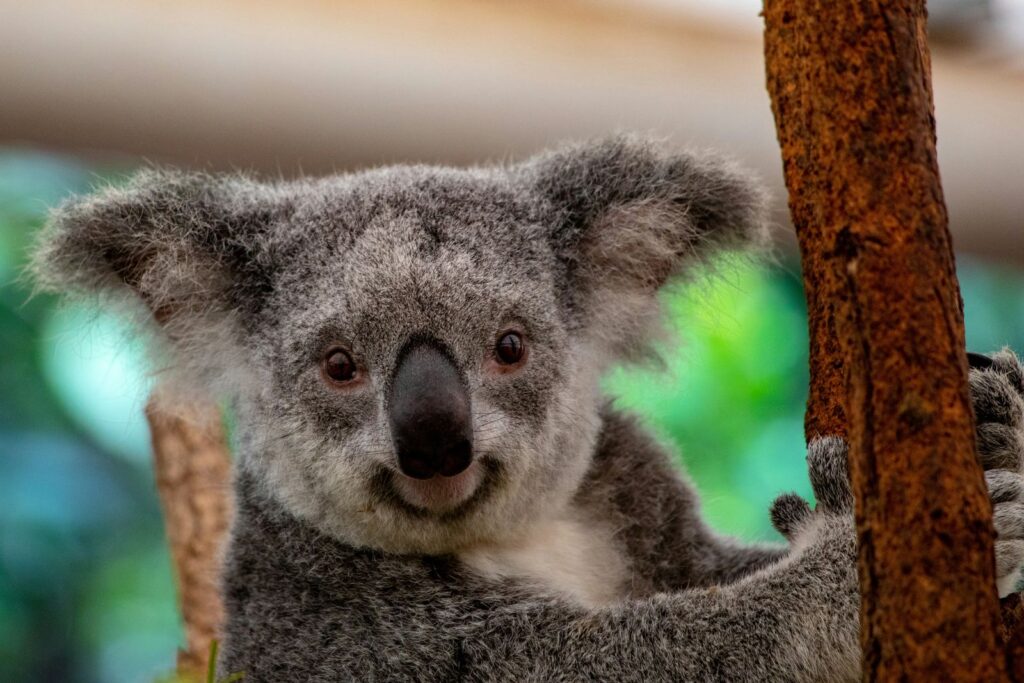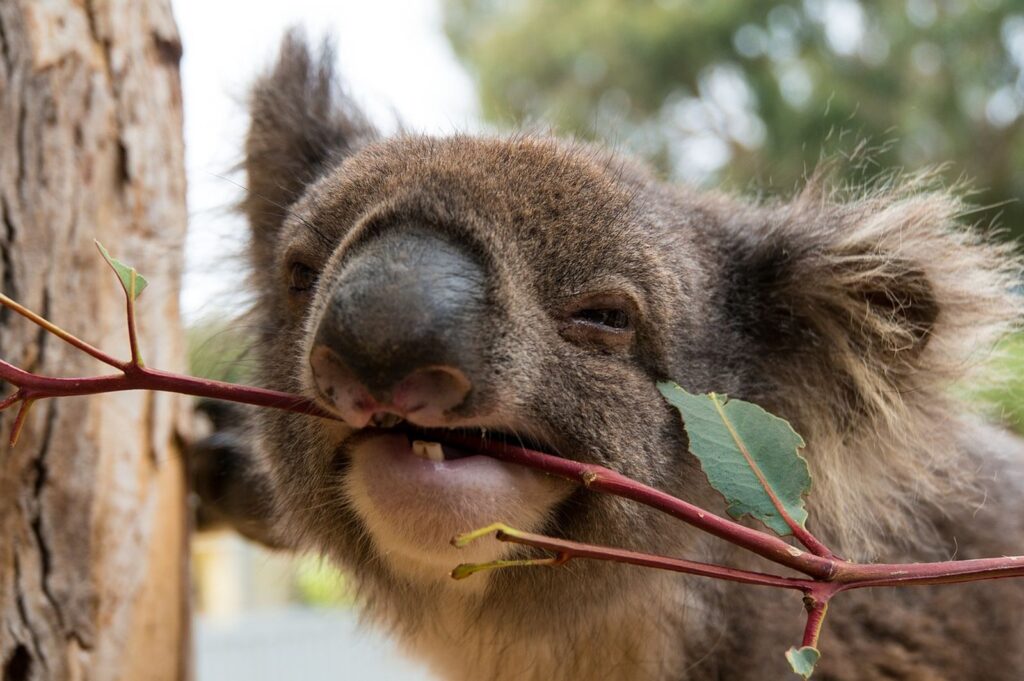The koala bear features several peculiar anatomical characteristics, some tailored to its arboreal and eucalyptus-centric lifestyle.
Koalas are 60-85 cm long and weigh 4-15 kg. They have dense fur for insulation and sharp claws with opposable digits, which make them great for climbing.
Their vestigial tails are suited to tree-dwelling, while males possess a brown scent gland for marking territory.
Koalas’ exceptional smell helps them detect safe eucalyptus leaves, and their specialized digestive system processes these tough, toxic leaves.
Main Takeaways
- Adapted for Arboreal Life: Koalas have sharp claws, opposable thumbs, and dense fur, all optimized for climbing and tree-dwelling.
- Specialized Sensory Abilities: Koalas have an excellent sense of smell to detect safe eucalyptus leaves and large ears for enhanced hearing.
- Sedentary Behavior: Due to their low-calorie diet, koalas conserve energy by sleeping up to 18 hours daily.
- Unique Reproductive Anatomy: Female koalas have complex reproductive systems with multiple possible outcomes for their oestrous cycle.
- Efficient Digestive System: Koalas have a specialized digestive system that ferments eucalyptus leaves, extracting essential nutrients while neutralizing toxins.
- Low Metabolic Rate: To compensate for their energy-poor diet, koalas have a low metabolic rate and rest significantly.

General Physical Characteristics of Koalas
Koalas exhibit a range of physical characteristics that are highly specialized for their arboreal lifestyle. With a body size ranging from 60 to 85 cm in length and a weight between 4 to 15 kg, koalas present sexual dimorphism, wherein males are typically larger than females. Their dense fur, varying from light grey to chocolate brown, insulates against temperature extremes.
One of the koala’s most notable physical adaptations is its sharp claws and opposable thumbs, essential for securely climbing and gripping tree branches.
Koalas possess a broad head but a small brain weighing approximately 19.2 grams. They also have a vestigial tail.
Male koalas exhibit unique physical characteristics, including a prominent brown scent gland on their chest, which is used for marking territory.
Sensory Abilities of Koalas – Nose, Eyes, Ears and Mouth
Koalas possess a great sense of smell. This olfactory ability allows them to detect eucalyptus leaves’ water content and toxic levels, ensuring they consume only safe leaves.
Their large ears are another sensory tool. They enhance their hearing and enable them to detect threatening sounds and other koalas.
Regarding communication, koalas utilize low-pitched sounds, especially during the breeding season. These vocalizations are produced by specialized vocal cords in the soft palate and are used to establish territory dominance and attract mates.
Koalas are characterized by poor long-range eyesight, but the sum of the other sensory abilities allows koalas to navigate their environment effectively.
Behavioural Characteristics of Koalas
Due to their diet, which is primarily composed of low-calorie eucalyptus leaves, koalas lead a sedentary lifestyle. They often sleep up to 18 hours daily to conserve energy.
When they do move, koalas exhibit a behavioural instinct to climb higher in trees when sensing danger, a strategy that provides a tactical escape from ground-based threats.

Reproductive Anatomy of Koalas
The reproductive anatomy of female koalas is characterized by unique features such as two lateral vaginae, duplex cervices, and a urogenital sinus, which opens in a cloaca, very similar to other marsupials. This particular reproductive system includes two uteri corresponding to the male’s bifurcated penis. This anatomical arrangement is essential for mating and subsequent reproductive success in this species.
The oestrous cycle of female koalas has three possible outcomes:
- Anovulatory Cycle: During this cycle, the female experiences proestrus, leading to estrus and the development of a preovulatory follicle. However, due to the absence of coital-seminal stimulation, ovulation does not occur. The preovulatory follicle undergoes atresia (degeneration), and a new wave of follicles develops.
- Ovulation with Pregnancy: In this scenario, coitus induces ovulation of the preovulatory follicle, forming a corpus luteum (CL). Conception occurs, resulting in pregnancy.
- Ovulation without Conception: Coitus induces ovulation, and a CL forms, but conception does not occur, leading to a failed pregnancy.
Research into the reproductive anatomy of female koalas is important, especially in understanding the impact of diseases like chlamydiosis, which can considerably affect reproductive health and success.

Digestive System of Koalas
An intricate digestive system enables koalas to subsist on a diet primarily composed of eucalyptus leaves, which are toxic to many other animals.
As hindgut fermenters, koalas rely on a large caecum to process these leaves and neutralize their toxic compounds. This specialized organ allows for the fermentation of fibrous plant material, which is essential for extracting critical nutrients. Approximately 10% of a koala’s energy is derived from this fermentation process.
The koala’s digestive system also includes specialized teeth for its unique dietary needs. Its incisors and cheek teeth are adept at grasping, snipping, and shredding eucalyptus leaves. Additionally, koalas can regurgitate food for a second chew, further aiding in the breakdown of tough plant material.
Given their diet’s low caloric content, koalas exhibit a low metabolic rate, conserving energy by spending significant amounts of time resting or sleeping. This energy conservation is fundamental to counterbalance the energy restrictions imposed by their eucalyptus-based diet.
Conclusions
Koalas exhibit a range of specialized anatomical and physiological adaptations that support their arboreal, eucalyptus-centric lifestyle. Their physical characteristics, including dense fur, sharp claws, and opposable digits, are well-suited for climbing and surviving in their tree-dwelling environment. Koalas also possess remarkable sensory abilities, particularly their acute sense of smell, crucial for selecting safe eucalyptus leaves to consume.
Behaviorally, koalas lead a sedentary life dictated by their low-calorie diet of eucalyptus leaves. Their unique reproductive anatomy and complex oestrous cycle underscore the importance of understanding their reproductive health, especially concerning diseases like chlamydiosis.
Koalas’ digestive systems are highly specialized, enabling them to detoxify and extract nutrients from eucalyptus leaves. This system supports their survival on a diet toxic to many other species but requires significant energy conservation strategies, such as extended rest periods. These adaptations collectively highlight the koala’s evolutionary success in a highly specialized ecological niche.



